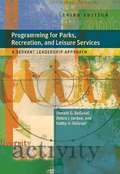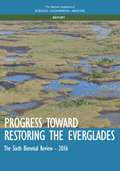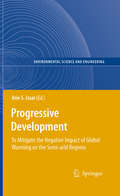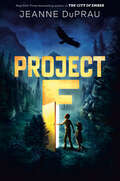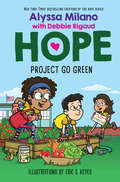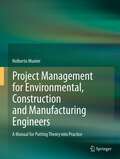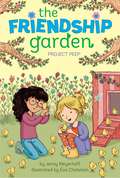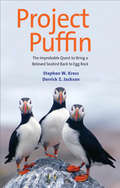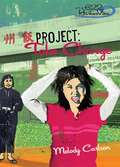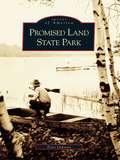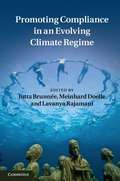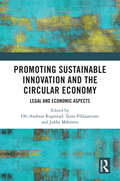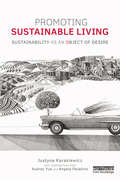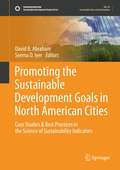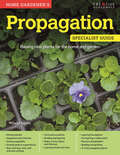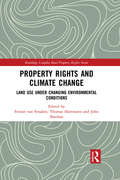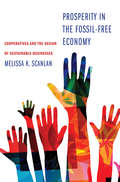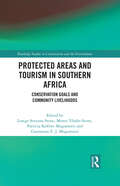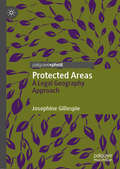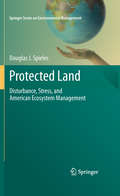- Table View
- List View
Professor Goose Debunks Goldilocks and the Three Bears (Professor Goose Debunks Fairy Tales #1)
by Paulette BourgeoisThe first in a new series by the author of Franklin the Turtle! Join Professor Goose in this STEM-filled picture book as she fact-checks classic fairy tales and shares the science behind these flawed stories.Mother Goose's fairy tales are NOT based in science, and her great niece Professor Goose thinks it's time to share the truth. Join Professor Goose as she — literally — travels through the pages of Goldilocks and the Three Bears, fact-checking, exposing the flaws and explaining the science. Bears don't live in cottages — they prefer dens! The smallest bowl of porridge wouldn't be "just right" — it would have been the coldest! Professor Goose is delighted to see Baby Bear use the scientific method and Goldilocks's fight or flight response. And maybe Goldilocks should have used a GPS so she wouldn't have gotten lost in the first place?Jammed with jokes and wonderfully silly illustrations, this book entertains while it introduces basic scientific laws and rules to young readers. At the back of the book, readers will find Professor Goose's instructions on how to engineer their own chair for a (teddy) bear!
Professor Goose Debunks The Three Little Pigs (Professor Goose Debunks Fairy Tales #2)
by Paulette BourgeoisThe second in a fractured fairy tale series by the author of Franklin the Turtle! Join Professor Goose in this STEM-filled picture book as she fact-checks classic fairy tales and shares the science behind these flawed stories.Mother Goose's fairy tales are NOT based in science, and her great niece Professor Goose thinks it's time to share the truth. Join Professor Goose as she — literally — travels through the pages of The Three Little Pigs, fact-checking, exposing the flaws and explaining the science. Did you know that pigs run in a zigzag pattern? And that there's no way a wolf's breath would be strong enough to blow down anything, even if he has his whole pack with him? And that hay bales are strong enough to resist most up, down and sideways forces? Sounds like the perfect material for building a house! . . . Or, not. But not to worry — Professor Goose is armed with helpful hints on how to make a structure strong enough to withstand hurricane forces! Jammed with jokes and hilarious illustrations, this book entertains while it introduces basic scientific laws and rules to young readers. At the back of the book, readers will find Professor Goose's new, carefully researched fairy tale ending as well as her favorite facts about coding!
Programming for Parks, Recreation, and Leisure Services: A Servant Leadership Approach (3rd Edition)
by Donald G. Degraaf Debra J. Jordan Kathy H. DegraafThis book is about the art and science of the complete programming process. The authors strive to go beyond merely presenting the knowledge and skills needed to provide quality programs; they suggest the integration of values into this process. They do this from a servant leadership perspective.
Progress Toward Restoring the Everglades: The Sixth Biennial Review - 2016
by Engineering Medicine National Academies of SciencesThe Everglades ecosystem is vast, stretching more than 200 miles from Orlando to Florida Bay, and Everglades National Park is but a part located at the southern end. During the 19th and 20th centuries, the historical Everglades has been reduced to half of its original size, and what remains is not the pristine ecosystem many image it to be, but one that has been highly engineered and otherwise heavily influenced, and is intensely managed by humans. Rather than slowly flowing southward in a broad river of grass, water moves through a maze of canals, levees, pump stations, and hydraulic control structures, and a substantial fraction is diverted from the natural system to meet water supply and flood control needs. The water that remains is polluted by phosphorus and other contaminants originating from agriculture and other human activities. Many components of the natural system are highly degraded and continue to degrade. Progress Toward Restoring the Everglades is the sixth biennial review of progress made in meeting the goals of the Comprehensive Everglades Restoration Plan (CERP). This complex, multibillion-dollar project to protect and restore the remaining Everglades has a 30-40 year timeline. This report assesses progress made in the various separate project components and discusses specific scientific and engineering issues that may impact further progress. According to Progress Toward Restoring the Everglades, a dedicated source of funding could provide ongoing long-term system-wide monitoring and assessment that is critical to meeting restoration objectives. This report examines the implications of knowledge gained and changes in widely accepted scientific understanding regarding pre-drainage hydrology, climate change, and the feasibility of water storage since the CERP was developed.
Progressive Development
by Arie S. IssarThe book is based on the results of the investigations of the authors in the semi-arid and arid regions (ASAR) of the globe. These investigations brought to the conclusion that the warming climate will cause the drying up of the water resources in these regions. In this case the principles of Sustainable Development will not be able to avert forthcoming catastrophes. These conclusions brought to the compilation of the policy of "Progressive Development", emphasising investment in the development of new water resources and changing the natural environments while advancing the local populations on the dimension of knowledge by education.
Project F
by Jeanne DuPrauFrom the bestselling author of The City of Ember comes a post-apocalyptic story set hundreds of years in the future, where life is simple and modern conveniences are a thing of the past until a boy enchanted by technology is forced to choose between doing the right thing for his community and pursuing his dreams of adventure.WELCOME TO THE FUTURE.There are no cars, planes, television, or smart phones. Climate change wreaked havoc on Earth hundreds of years ago, and now people live a simpler life. Then thirteen-year-old Keith uncovers a secret. It&’s a mysterious mission known only as Project F. It&’s advanced, it&’s scientific, and it&’s going to change the world. It&’s exactly the kind of adventure Keith has always longed to be a part of.And what is adventure without a little danger, right? But how much danger is Keith willing to risk? For himself? For his family? For his community? For the entire world…?Jeanne DuPrau's The City of Ember was an instant hit when it arrived on bookshelves. It has become a modern classic beloved by readers selling hundreds of thousands of copies a year! In her latest novel, she explores timely questions about the Earth and our use of its resources. A bold novel, Project F asks how much you are willing to risk to save the future.
Project Go Green (Alyssa Milano's Hope)
by Debbie Rigaud Alyssa MilanoHope Roberts saves the planet!In the fourth book in Alyssa Milano's funny and relatable middle-grade series, Hope Roberts is determined to save the worldliterally. Hope has already gotten her school to add more recycling bins and coordinate a carpooling program. But it's not enough. Hope wants to do more to protect the environment before it's too late. But will Hope's plans to help the planet backfire?Hope's relatability, kindness, empathy, and can-do attitude will inspire a generation of do-gooders. This series is a response to the very palpable feeling that not only can young people save the worldthey will!This story will include Hope's tips about recycling and protecting the environment in the back of the book!
Project Management for Environmental, Construction and Manufacturing Engineers: A Manual for Putting Theory into Practice
by Nolberto MunierAs a companion to books on project-management theory, this book illustrates, in a down-to-earth, comprehensive style, how to put that theory into practice. In addition to the many examples that illustrate procedures, the book includes over 25 case studies, each one addressing a specific theme. Key topics, such as project selection, negotiations, planning and scheduling, cost and budgeting, project control, human resources, environmental impacts, risk management, and financial evaluation, are discussed, using a step-by-step approach. Beginning at the grassroots level, some cases are solved by hand to illustrate the mechanics of a procedure, while others are solved using advanced computer programs. In this way the reader has a clear idea of the problem, how and when to raise the issue, information needed (and who can provide it), how to solve it by hand, when possible, and also its resolution using the latest informatics tools.
Project Peep
by Éva Chatelain Jenny MeyerhoffAnna and her community gardening friends spring into action to help raise baby chicks in the third book in the Friendship Garden series.When Anna moved to Chicago, Kaya became her first real friend, so for her birthday Anna is determined to give Kaya the best present ever! The problem is, the thing Kaya wants more than anything is a pet, but her parents have a strict no-pets rule. Then Anna remembers that Mr. Hoffman's third-grade class just hatched baby chicks! Anna decides that rather than sending the chicks back to the farm, she'll convince her teacher to let the Friendship Garden raise them, so Kaya can have a pet of her own. But raising chicks is no easy task. It requires supplies (that cost money) and building things like a coop and a run. How is Anna supposed to get everything ready and keep it a surprise...especially when Anna and Kaya usually hang out every day? Kaya begins to suspect "fowl play" and assumes Anna is ditching her as a friend! Anna feels terrible and what was supposed to be the best birthday present ever quickly turns into the worst one. Will Anna be able to come up with a way to win her best friend back before the chicks get sent back to the farm for good?
Project Puffin
by Derrick Z. Jackson Stephen W. KressDetails a wildlife scientist's successful efforts to restore puffin colonies in Maine through an experiment in habitat restoration.
Project Star: The Universe In Your Hands
by Harold P. Coyle Harvard Observatory StaffFun activities to learn about the universe and astronomy.
Project WILD K-12 Curriculum & Activity Guide
by Council for Environmental EducationProject WILD is an interdisciplinary conservation and environmental education program emphasizing wildlife. The goal of Project WILD is to assist students of any age in developing awareness, knowledge, skills, and commitment to result in informed decisions, responsible behavior, and constructive actions concerning wildlife and the environment.
Project: Take Charge (Girls of 622 Harbor View, Book 4)
by Melody CarlsonWhen vandals trash McPhearson Park, Amy leads the way as she, Morgan, Carlie, Emily, and Chelsea, the newest club member, make it their project to save the spot from being turned into a parking lot and restore it to a place of beauty and fun.
Promised Land State Park
by Peter OsborneLocated in the northeastern corner of Pennsylvania is a beautiful state park with the compelling name of Promised Land. It is visited by thousands annually, and many of those visitors have been coming to the park for generations. Promised Land State Park features more than 200 images that have been preserved by the state park, state agencies, historical organizations, and individuals. Through these unique images, many published here for the first time, the fascinating history of one of Pennsylvania's most popular parks is documented.
Promoting Compliance in an Evolving Climate Regime
by Jutta Brunnée Lavanya Rajamani Meinhard DoelleAs the contours of a post-2012 climate regime begin to emerge, compliance issues will require increasing attention. This volume considers the questions that the trends in the climate negotiations raise for the regime's compliance system. It reviews the main features of the UN Framework Convention on Climate Change and its Kyoto Protocol, canvasses the literature on compliance theory and examines the broader experience with compliance mechanisms in other international environmental regimes. Against this backdrop, contributors examine the central elements of the existing compliance system, the practice of the Kyoto compliance procedure to date and the main compliance challenges encountered by key groups of states such as OECD countries, economies in transition and developing countries. These assessments anchor examinations of the strengths and weaknesses of the existing compliance tools and of the emerging, decentralized, 'bottom-up' approach introduced by the 2009 Copenhagen Accord and pursued by the 2010 Cancun Agreements.
Promoting Sustainable Innovation and the Circular Economy: Legal and Economic Aspects
by Ole-Andreas Rognstad, Taina Pihlajarinne and Jukka MähönenThe book explores the role of public market actors in sustainable and circular economy innovation and financing.The shift to a circular economy requires active innovation, alongside radical changes in law, finance and policy considerations, since regulation is often tightly connected with the assumption of a linear model of consumption. Finance is crucial in creating sustainable and circular economy markets and innovations: public finance is important from the perspective of seeing the state as an engine for promoting sustainable innovations, but private funds are also required. Legislative initiatives for promoting repairs have been proposed or adopted in the EU, US and in Australia, representing remarkable steps forward but still leaving many obstacles without legislative intervention. This book examines circular economy regulation and policy on a comprehensive, general level, as well as assessing the regulatory possibilities of promoting the right to repair. Promotion of circular economy innovations as well as changing the practices and changing consumer patterns towards a more comprehensive adoption of CE are discussed from perspectives of legal, social and moral norms. The book critically evaluates current legislative reforms and assesses existing barriers to the circular economy and innovation in intellectual property law, consumer law and competition law.Providing an in-depth analysis of this dynamic field, geared towards reconsidering both existing and prospective policies and regulatory regime, the book makes recommendations for solutions to legislative barriers. It is an indispensable resource for both researchers and practitioners working at the intersections of markets, innovations and sustainability.
Promoting Sustainable Living: Sustainability as an Object of Desire (Routledge Studies in Sustainability)
by Audrey Yue Justyna Karakiewicz Angela PaladinoCurrent images of sustainability are often designed to instil fear and force change, not because we believe in it, but because we fear the consequences of inaction. Moving away from negative portrayals of sustainability, this book identifies the factors that motivate people to aspire towards sustainable living. It introduces the notion of sustainability as an "object of desire" that will allow people not to be scared of the future but rather to dream about it and look forward to a better quality of life. Tracing the history of major changes in our society that have dramatically altered our perceptions, beliefs and attitudes about sustainability, the book analyses the role of communications in persuading people of the benefits of sustainable living. It describes our current desires and dreams and explains why we need to change. Finally, the book suggests what could be done to not only make sustainability an object of desire, but also introduce hopes and dreams for a better future into our everyday lives. This inspiring and interdisciplinary book provides innovative insights for researchers, students and professionals in a range of disciplines, in particular environment and sustainability, sustainable marketing and advertising, and psychology.
Promoting the Sustainable Development Goals in North American Cities: Case Studies & Best Practices in the Science of Sustainability Indicators (Sustainable Development Goals Series)
by David B. Abraham Seema D. IyerThis volume presents North American best practices and perspectives on developing, managing and monitoring indicators to track development progress towards the Sustainable Development Goals (SDGs) in local communities and cities. In 4 main sections, the book presents and frames the many ways in which community indicator programs are either integrating or retooling to integrate the SDGs into their existing frameworks, or how they are developing new programs to track and report progress on the SDGs. This is the first volume that focuses on SDG adoption within the context of North Americans cities and communities, and the unique issues and opportunities prevalent in these settings. The chapters are developed by experienced academics and practitioners of community planning and sustainable development, and will add broad perspective on public policy, organizational management, information management and data visualization. This volume presents a case-study approach to chapters, offering lessons that can be used by three main audiences: 1) teachers and researchers in areas of urban, regional, and environmental planning, urban development, and public policy; 2) professional planners, decision-makers, and urban managers; and 3) sustainability activists and interested groups.
Propagation: Raising new plants for the home and garden (Home Gardener's)
by David SquireA comprehensive guide to cultivating new plants, from vegetables and flowers to shrubs and succulents, containing techniques for a wide variety of species. Buying individual plants can be expensive—but raising your own saves money and gives lots of gardening satisfaction. Every aspect of the art of propagation is covered, from the philosophy behind creating plants to the easiest species to grow to the best materials and equipment. All the major methods receive well-illustrated, in-depth, and easy to follow explanations, including seeds and cuttings, division and layering, and budding and grafting, and there&’s a handy, at-a-glance A–Z listing of ideal propagation plants for the home and garden. Both novice and more experienced gardeners will turn to this invaluable reference again and again.
Property Rights and Climate Change: Land use under changing environmental conditions (Routledge Complex Real Property Rights Series)
by Thomas Hartmann Fennie Van Straalen John SheehanProperty Rights and Climate Change explores the multifarious relationships between different types of climate-driven environmental changes and property rights. This original contribution to the literature examines such climate changes through the lens of property rights, rather than through the lens of land use planning. The inherent assumption pursued is that the different types of environmental changes, with their particular effects and impact on land use, share common issues regarding the relation between the social construction of land via property rights and the dynamics of a changing environment. Making these common issues explicit and discussing the different approaches to them is the central objective of this book. Through examining a variety of cases from the Arctic to the Australian coast, the contributors take a transdisciplinary look at the winners and losers of climate change, discuss approaches to dealing with changing environmental conditions, and stimulate pathways for further research. This book is essential reading for lawyers, planners, property rights experts and environmentalists.
Prosperity in the Fossil-Free Economy: Cooperatives and the Design of Sustainable Businesses
by Melissa K ScanlanA blueprint for creating sustainable businesses, emphasizing the power and potential of cooperative models Drawing on both her extensive experience founding and directing social enterprises and her interviews with sustainability leaders, Melissa Scanlan provides a legal blueprint for creating alternate corporate business models that mitigate climate change, pay living wages, and act as responsible community members, including Certified B Corps and benefit corporations. With an emphasis on cooperatives, this book reveals the power and potential of cooperating as a unifying concept around which to design social enterprise achieving triple bottom-line results: for society, the environment, and finance.
Protected Areas and Tourism in Southern Africa: Conservation Goals and Community Livelihoods (Routledge Studies in Conservation and the Environment)
by Lesego Senyana StoneThis volume discusses the complex relationship between Protected Areas and tourism and their impact on community livelihoods in a range of countries in Southern Africa. Protected areas and tourism have an enduring and symbiotic relationship. While protected areas offer a desirable setting for tourism products, tourism provides revenue that can contribute to conservation efforts. This can bring benefits to local communities, but it can also have a negative impact, with the establishment of protected areas leading to the eviction of local communities from their original places of residence, while also preventing them from accessing the natural resources they once enjoyed. Taking a multi-disciplinary approach, this book addresses the opportunities and challenges faced by communities and other stakeholders as they endeavour to achieve their conservation goals and work towards improving community livelihoods. Case studies from Botswana, Malawi, Namibia, South Africa, Tanzania, Zambia and Zimbabwe address key issues such as human–wildlife conflicts, ecotourism, wildlife-based tourism, landscape governance, wildlife crop-raiding and trophy hunting, including the high-profile case of Cecil the lion. Chapters highlight both the achievements and positive outcomes of protected areas, but also the challenges faced and their impact on how protected areas are viewed and also conservation priorities more generally. The volume gives these issues affecting protected areas, local communities, managers and international conservation efforts centre stage in order inform policy and improve practice going forward. This book will be of great interest to students and scholars of conservation, natural resource management, tourism, sustainable development and African studies, as well as professionals and policymakers involved in conservation policy.
Protected Areas in Northern Tanzania: Local Communities, Land Use Change, and Management Challenges (Geotechnologies and the Environment #22)
by Ryan R. Jensen Jeffrey O. Durrant Emanuel H. Martin Kokel Melubo Leslie A. Hadfield Perry J. Hardin Laurie WeislerNorthern Tanzania is an important and diverse ecological and cultural region with many protected lands. This book, Protected Areas in Northern Tanzania, brings to the forefront research on significant issues and developments in conservation and management in national parks and protected lands in northern Tanzania. The book draws attention to issues at the intersection of conservation, tourism, and community livelihood, and several studies use geospatial technologies—Geographic Information Systems and remote sensing data and techniques—to study land use and land cover conversion. With contributions from professors at the Mweka College of African Wildlife Management located at the foot of Mount Kilimanjaro and other Tanzanian researchers, the book provides important perspectives of local experts and practitioners. Protected Areas in Northern Tanzania provides a significant contribution in research and technological advancement in the areas of wildlife conservation and protected land management throughout this critical region.
Protected Areas: A Legal Geography Approach
by Josephine GillespieThis book argues that legal geography provides new insights into contemporary conservation challenges. Despite unprecedented efforts, we are facing an extinction crisis, and in situ protected area programs are falling short. This book discusses the protected area phenomenon and calls for changes to current approaches, informed by legal geography –an inter-disciplinary area focused on the intertwined people–place–law dynamics that enable, or disable, effective management practices. The book examines two protected area types: World Heritage Sites, where places of ‘outstanding universal value’ are protected for all humanity, and Ramsar protected wetland sites, one of the first global environmental protection initiatives. Using case studies from the Australasian region (Australia, the Pacific and Southeast Asia), it reveals how current approaches can be improved by taking into account the people–place–law nexus embedded in legal geography research.
Protected Land
by Douglas J. SpielesThis is a book about ecosystems: the ways in which we perceive them, conceptualize them,protect them, and manipulate them. Ecosystems have been given considerable attention inrecent literature, and with good reason. Our growing comprehension of irreplaceable andimperiled ecosystem services has made it clear that we are in the midst of an ecological crisis.In response, various organizations, agencies, and individuals have dedicated themselves to thepreservation, restoration, and maintenance of ecological systems. The United States is a worldleader in this regard, building upon the legacy of giants like Thoreau, Muir, and Leopold.And yet, even as we scramble to rehabilitate and sustain ecosystems, the debate on their naturecontinues. In one corner are proponents of holism--those that see ecosystems as definableunits with recognizable and regenerative stable states.


